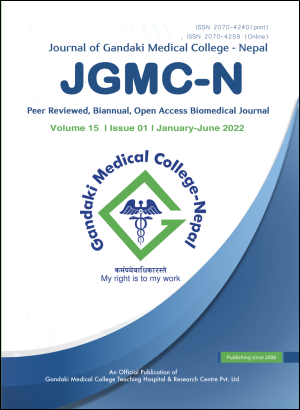Validation of TIMI risk score for STEMI patients visiting a tertiary care hospital of western Nepal
DOI:
https://doi.org/10.3126/jgmcn.v15i1.43993Keywords:
Coronary re-perfusion, myocardial infarction, risk scores, validationAbstract
Introduction: Cardiovascular disease is the leading cause of death globally, and ST elevation myocardial infarction remains main contributor to this mortality. Thrombolysis in myocardial infarction risk score which was derived from randomized clinical trials has been validated in non-selected western patient populations. The objective of this study was to find out the applicability of Thrombolysis in myocardial infarction risk score in our study population.
Methods: A prospective observational study was conducted in admitted patients of cardiology unit, Manipal teaching hospital from February 25, 2020 to December 31, 2021. All consecutive patients admitted with diagnosis of acute ST elevation myocardial infarction were selected. Patients admitted with diagnosis of ST segment elevation myocardial infarction and undergone either primary, rescue or elective coronary reperfusion therapy were included for analysis.
Results: Total of 339 cases with mean age of 60.62 ±12.64 were diagnosed to have acute ST elevation myocardial infarction and undergone coronary reperfusion therapy. Nearly two third cases were male and majority (61.35%) cases were below age of 65 years. Age of 65 years and above, Killip class III-IV [OR:20.54 (CI: 8.63–48.87), p<0.001], low HDL [(OR:0.481 (CI: 0.23 – 0.97) p= 0.038], heart rate >100 beats/ min [(OR: 5.79 (CI: 2.81 – 11.92), p<0.001] and anterior wall involvement [(OR: 2.8 (CI: 1.39–6.41), p=0.004] were significantly associated with 30 days mortality.
Conclusions: Thrombolysis in myocardial infarction risk score is applicable in clinical practice for better risk stratified treatment in our setting.
Downloads
Downloads
Published
How to Cite
Issue
Section
License
Copyright (c) 2022 Ram Chandra Kafle, Dibya Sharma, Daya Ram Pokharel

This work is licensed under a Creative Commons Attribution-NonCommercial 4.0 International License.
This license allows reusers to distribute, remix, adapt, and build upon the material in any medium or format for noncommercial purposes only, and only so long as attribution is given to the creator.




